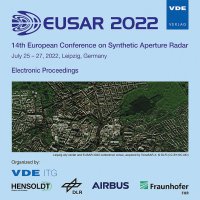Along Track Interferometry (ATI) versus Doppler Centroid Anomaly (DCA) Estimation of Ocean Surface Radial Velocity using RADARSAT-2 Modex-1 ScanSAR Data
Konferenz: EUSAR 2022 - 14th European Conference on Synthetic Aperture Radar
25.07.2022 - 27.07.2022 in Leipzig, Germany
Tagungsband: EUSAR 2022
Seiten: 5Sprache: EnglischTyp: PDF
Autoren:
Ahmed, Usman Iqbal; Rabus, Bernhard (SARlab, School of Engineering Sciences, Simon Fraser University (SFU), Burnaby, Canada)
Geudtner, Dirk (European Space Agency, ESA-ESTEC, Germany)
Rashid, Mamoon; Gierull, Christoph (Defence R&D Canada - Ottawa, Department of National Defence, Ottawa, Canada)
Inhalt:
Monitoring ocean surface parameters plays an important role in assessing climate change as well as in disaster and ocean traffic management. Ocean surface radial velocity estimation using various SAR sensors has been successfully demonstrated in the past both with Along Track Interferometry (ATI) and Doppler Centroid Anomaly (DCA) techniques. Simon Fraser University (SFU) with the kind support of European Space Agency (ESA), German Space Agency (DLR) and Defence Research and Development Center (DRDC)-Ottawa have conducted a study to compare ATI and DCA techniques for RADARSAT-2 Moving Object Detection Experiment (RS-2 Modex-1) datasets; and then further to cross-analyze these results with other SAR sensor radial velocity products for the same test sites simultaneously (i.e. TerraSAR-X (TSX)/Tandem-X (TDX) ATI and Sentinel-1 DCA products). The study has been motivated by previously observed challenges faced in the DCA analyses for the Sentinel-1 Terrain Observation with Progressive Scan (TOPS) mode, manifesting as discontinuities within sub-swaths for the derived radial velocity; evaluating ATI as an alternative technique. Here, we are presenting ATI and DCA results for RS-2 Modex-1 ScanSAR data for one of the datasets collected over the Agulhas current. The ScanSAR datasets were focused into SLCs with a full aperture approach. ATI products were derived using conventional interferometric techniques for the fore and aft SLC channels. Corresponding DCA products were derived for a single SLC channel with a variant of Madsen‘s method using the same interferometric techniques for the original but de-whitened SLC channel and an appropriately azimuth shifted copy of this. The casting of both ATI and DCA into the same interferometric framework rendering both measurements as an interferometric phase simplifies a quantitative “apples to apples” comparison of sensitivity and noise levels for both techniques. For RS-2 Modex 1 ScanSAR data we were able to produce high resolution ATI ocean surface velocity maps of 160 m x 160 m spatial resolution (ground range), while to achieve DCA products with comparable phase noise levels required us to lower final resolution significantly to about 1.5 km x 1.5 km (ground range). Results were cross validated with Ocean Surface Current Analyses Real-time (OSCAR) data for the radial surface velocity and with historical AIS data for vessel velocities. The presented is a first sample of future detailed analysis results from coincident acquisitions for 14 different sites worldwide with RS-2 Modex-1, TSX/TDX ATI and S-1 TOPS mode to provide a fully quantitative suitability assessment of ATI and DCA method based on a comprehensive inter method and cross sensor comparison.


